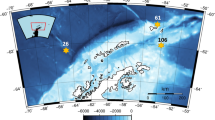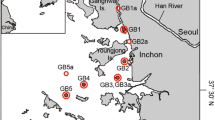We analyzed the strength of phytoplankton–bacterioplankton coupling by comparing the rate of particulate (PPP) and dissolved primary production (DPP) with bacterial carbon demand (BCD) in four contrasting marine regions: offshore and coastal waters of the Southern Ocean, a coastal area of the NE Atlantic, and a coastal–offshore transect in the NW Mediterranean. We measured bacterial heterotrophic production (BHP) and estimated BCD from a literature model. Average phytoplanktonic percent extracellular release [PER = DPP/(DPP + PPP)] was 18–20% in the Antarctic (offshore and coastal, respectively), 16% in the NW Mediterranean, and 7% in the NE Atlantic. A significant inverse relationship was found between PER and total system productivity with pooled data. On average BHP amounted to <5% of total primary production in all regions. However, the strength of phytoplankton–bacterioplankton coupling, estimated as the potential importance of DPP in meeting BCD, differed greatly in the four regions. DPP was highly correlated to BCD in offshore Antarctic waters and was sufficient to meet BCD. In contrast, BCD exceeded DPP and bore no significant relationship in the remaining regions. The data suggest that a strong dependence of bacteria on algal extracellular production is only expected in open-ocean environments isolated from coastal inputs of DOC.
Similar content being viewed by others
Author information
Authors and Affiliations
Rights and permissions
About this article
Cite this article
Morán, X., Estrada, M., Gasol, J. et al. Dissolved Primary Production and the Strength of Phytoplankton– Bacterioplankton Coupling in Contrasting Marine Regions . Microb Ecol 44, 217–223 (2002). https://doi.org/10.1007/s00248-002-1026-z
Received:
Accepted:
Issue Date:
DOI: https://doi.org/10.1007/s00248-002-1026-z





